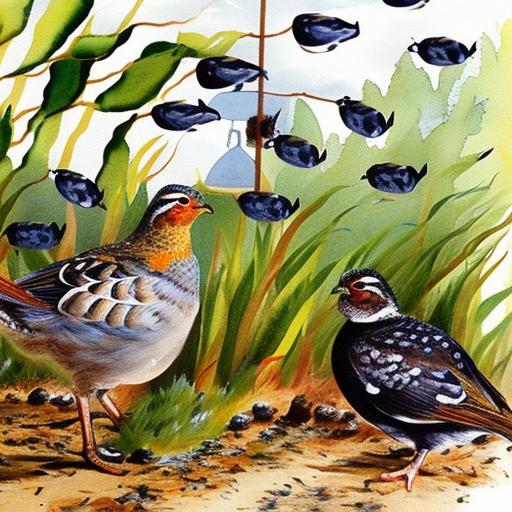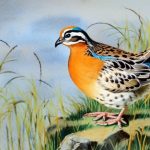When it comes to setting up a quail breeding operation, choosing the right location is crucial for the success of your venture. The first consideration should be the climate and weather conditions of the area. Quails are sensitive to extreme temperatures, so it’s important to select a location with a moderate climate. Additionally, the location should have good ventilation to ensure that the quails have access to fresh air and are not exposed to harmful gases or odors.
Another important factor to consider is the availability of space. Quails require a significant amount of space to move around and forage for food. Therefore, it’s essential to choose a location that provides enough room for the quails to roam freely. Additionally, the location should be secure and protected from predators such as foxes, raccoons, and birds of prey. It’s also important to consider the proximity to a water source, as quails require constant access to clean water for drinking and bathing. Lastly, the location should be easily accessible for maintenance and monitoring of the quail breeding setup.
In conclusion, when choosing the right location for your quail breeding setup, it’s important to consider the climate, ventilation, space, security, proximity to water source, and accessibility. By carefully considering these factors, you can ensure that your quail breeding operation is set up for success.
Key Takeaways
- Choose a location with good ventilation, protection from predators, and easy access for maintenance and monitoring.
- Design the quail enclosure with proper flooring, nesting areas, and perches to ensure the comfort and safety of the quails.
- Select equipment such as feeders, waterers, and lighting that are suitable for quail breeding and easy to clean and maintain.
- Create an ideal environment with proper temperature, humidity, and cleanliness to promote healthy quail breeding.
- Select breeding stock with good genetics, health, and temperament to ensure successful breeding and production of healthy offspring.
- Manage the breeding process by monitoring egg production, incubation, and hatching, and providing proper care for the quails at each stage.
- Ensure the health and well-being of the quail breeding setup by implementing biosecurity measures, regular health checks, and proper nutrition and hygiene practices.
Designing and Building the Quail Enclosure
Once you have chosen the right location for your quail breeding setup, the next step is to design and build the quail enclosure. The first consideration when designing the enclosure is the size and layout. Quails require a significant amount of space to move around and forage for food, so it’s important to provide enough room for them to roam freely. Additionally, the enclosure should be divided into separate areas for breeding, nesting, and feeding to ensure that the quails have access to all their essential needs.
The next consideration is the materials used for building the enclosure. The materials should be durable, easy to clean, and provide adequate protection from predators. Common materials used for building quail enclosures include wire mesh, wood, and metal. It’s important to ensure that the enclosure is well-ventilated to provide fresh air for the quails and prevent the buildup of harmful gases or odors.
In conclusion, when designing and building the quail enclosure, it’s important to consider the size and layout, as well as the materials used for construction. By carefully planning and constructing the enclosure, you can provide a safe and comfortable environment for your quails to thrive and breed successfully.
Selecting the Right Equipment for Your Quail Breeding Setup
Selecting the right equipment is essential for the success of your quail breeding setup. The first piece of equipment to consider is the brooder. A brooder is essential for providing a warm and safe environment for newly hatched quail chicks. It’s important to choose a brooder that is spacious enough to accommodate the number of chicks you plan to raise and is equipped with a heat source to maintain the appropriate temperature.
Another important piece of equipment is the feeders and waterers. Quails require constant access to clean water and high-quality feed for optimal growth and development. It’s important to choose feeders and waterers that are easy to clean and refill, as well as durable enough to withstand the pecking and scratching of the quails.
Additionally, it’s important to invest in a reliable egg incubator if you plan to hatch your own quail eggs. An egg incubator provides a controlled environment for hatching eggs and ensures a high hatch rate. It’s important to choose an incubator with precise temperature and humidity controls to maximize the chances of successful hatching.
In conclusion, selecting the right equipment for your quail breeding setup is crucial for the health and well-being of your quails. By investing in quality brooders, feeders, waterers, and egg incubators, you can provide a comfortable and nurturing environment for your quails to thrive and reproduce successfully.
Creating the Ideal Environment for Quail Breeding
Creating the ideal environment for quail breeding is essential for the success of your breeding operation. The first consideration is providing a suitable nesting area for your quails. Quails prefer to nest in secluded areas with soft bedding material such as straw or hay. It’s important to provide nesting boxes or shelters that are spacious enough to accommodate multiple hens and provide privacy for laying eggs.
Another important aspect of creating the ideal environment for quail breeding is providing a balanced diet. Quails require a high-protein diet to support egg production and optimal growth. It’s important to provide a commercial game bird feed that is specifically formulated for quails, as well as access to fresh greens, insects, and grit for digestion.
Additionally, it’s important to provide adequate lighting in the quail enclosure. Quails require a consistent light cycle to stimulate egg production and maintain healthy reproductive behavior. It’s important to provide 14-16 hours of light per day using artificial lighting or natural sunlight to ensure that your quails are receiving the necessary light exposure.
In conclusion, creating the ideal environment for quail breeding involves providing suitable nesting areas, a balanced diet, and adequate lighting. By carefully considering these factors, you can create a nurturing environment that promotes successful breeding and healthy development of your quail flock.
Selecting the Right Quail Breeding Stock
Selecting the right quail breeding stock is crucial for establishing a healthy and productive flock. The first consideration when selecting breeding stock is choosing birds with desirable traits such as good health, strong genetics, and high egg production. It’s important to select birds from reputable breeders or suppliers who can provide information about the lineage and health history of the birds.
Another important factor to consider is genetic diversity. Inbreeding can lead to genetic abnormalities and reduced fertility in quails, so it’s important to select breeding stock from different bloodlines to maintain genetic diversity within the flock. Additionally, it’s important to avoid selecting birds with any signs of disease or deformities to ensure that you are starting with a healthy foundation for your breeding operation.
It’s also important to consider the age of the breeding stock. Younger birds are generally more fertile and productive than older birds, so it’s important to select breeding stock that is in their prime reproductive years. Additionally, it’s important to maintain a balanced ratio of males to females within the breeding stock to ensure successful mating and egg production.
In conclusion, selecting the right quail breeding stock involves choosing birds with desirable traits, maintaining genetic diversity, avoiding birds with signs of disease or deformities, and considering the age and gender ratio of the breeding stock. By carefully selecting high-quality breeding stock, you can establish a healthy and productive flock that will contribute to the success of your quail breeding operation.
Managing the Quail Breeding Process

Managing the quail breeding process involves several key tasks that are essential for maintaining a healthy and productive flock. The first task is monitoring egg production and fertility. It’s important to keep track of the number of eggs laid by each hen and monitor fertility rates by regularly checking for fertile eggs using a process called candling. This allows you to identify any issues with egg production or fertility early on and take corrective measures if necessary.
Another important aspect of managing the quail breeding process is ensuring proper incubation of eggs. If you plan to hatch your own quail eggs, it’s important to carefully monitor temperature and humidity levels in the incubator to ensure successful hatching. It’s also important to handle eggs with care during collection and storage to prevent any damage that could affect hatchability.
Additionally, it’s important to monitor the health and behavior of your quails on a regular basis. This includes observing their eating habits, activity levels, and overall appearance for any signs of illness or distress. It’s also important to maintain a clean and sanitary environment within the quail enclosure by regularly cleaning bedding material, feeders, waterers, and nesting areas.
In conclusion, managing the quail breeding process involves monitoring egg production and fertility, ensuring proper incubation of eggs, and maintaining the health and well-being of your quails through regular observation and maintenance. By carefully managing these aspects of the breeding process, you can ensure that your quail flock remains healthy and productive.
Ensuring the Health and Well-being of Your Quail Breeding Setup
Ensuring the health and well-being of your quail breeding setup is essential for maintaining a successful breeding operation. The first step in ensuring the health of your quails is implementing a regular vaccination program. Vaccinations can protect your quails from common diseases such as Newcastle disease, infectious bronchitis, and fowl pox. It’s important to consult with a veterinarian or poultry health expert to develop a vaccination schedule that is appropriate for your specific breed of quails.
Another important aspect of ensuring the health of your quails is providing proper nutrition. Quails require a balanced diet that is high in protein to support egg production and optimal growth. It’s important to provide commercial game bird feed that is specifically formulated for quails, as well as access to fresh greens, insects, and grit for digestion.
Additionally, it’s important to practice good biosecurity measures within your quail breeding setup. This includes implementing strict hygiene practices such as regularly cleaning feeders, waterers, nesting areas, and removing any waste material from the enclosure. It’s also important to limit exposure of your quails to wild birds or other potential sources of disease transmission.
In conclusion, ensuring the health and well-being of your quail breeding setup involves implementing a regular vaccination program, providing proper nutrition, and practicing good biosecurity measures. By taking these steps, you can protect your quails from common diseases and maintain a healthy and productive breeding operation.
If you’re considering setting up a quail breeding operation, it’s essential to have a well-designed and functional quail coop. Poultry Wizard offers valuable insights into creating the perfect chicken coop in their article “10 Essential Features of a Chicken Coop,” which can also be applied to quail housing. Additionally, understanding the space requirements for chickens in “How Many Chickens Do You Need for a Family of 4?” can provide helpful guidance when planning the size of your quail breeding setup.
FAQs
What is a quail breeding setup?
A quail breeding setup refers to the environment and equipment used for breeding and raising quails. This includes the housing, nesting areas, feeding and watering systems, and other necessary infrastructure for successful quail breeding.
What are the key components of a quail breeding setup?
Key components of a quail breeding setup include a suitable housing structure, nesting boxes, feeders, waterers, lighting, heating, and ventilation systems. These components are essential for creating a comfortable and productive environment for quail breeding.
What type of housing is suitable for quail breeding?
Housing for quail breeding can include cages, hutches, or aviaries. The housing should provide enough space for the quails to move around comfortably and should be designed to protect them from predators and harsh weather conditions.
What kind of nesting boxes are recommended for quail breeding?
Nesting boxes for quail breeding should be designed to provide a safe and comfortable space for the quails to lay their eggs. They should be easy to clean and maintain, and provide privacy for the quails to encourage successful breeding.
What feeding and watering systems are ideal for quail breeding?
For feeding, quails can be provided with commercial quail feed or a balanced diet of grains, seeds, and greens. Waterers should be designed to provide clean and easily accessible water for the quails at all times.
What are the important considerations for lighting, heating, and ventilation in a quail breeding setup?
Proper lighting, heating, and ventilation are crucial for maintaining a healthy and productive quail breeding environment. Adequate lighting helps to stimulate egg production, while heating and ventilation systems help to regulate temperature and air quality within the breeding setup.
What are the best practices for maintaining a quail breeding setup?
Regular cleaning and disinfection of the breeding setup, providing a balanced diet, monitoring the health of the quails, and ensuring proper environmental conditions are essential for maintaining a successful quail breeding setup. Regular observation and care are also important for the well-being of the quails.
Meet Walter, the feathered-friend fanatic of Florida! Nestled in the sunshine state, Walter struts through life with his feathered companions, clucking his way to happiness. With a coop that’s fancier than a five-star hotel, he’s the Don Juan of the chicken world. When he’s not teaching his hens to do the cha-cha, you’ll find him in a heated debate with his prized rooster, Sir Clucks-a-Lot. Walter’s poultry passion is no yolk; he’s the sunny-side-up guy you never knew you needed in your flock of friends!







